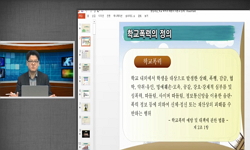School violence has emerged as a social problem in Korea and developed countries around the 1980s. The severity of school violence is influenced by a variety of factors, including admission-oriented education, lack of care, and exposure to the media. ...
http://chineseinput.net/에서 pinyin(병음)방식으로 중국어를 변환할 수 있습니다.
변환된 중국어를 복사하여 사용하시면 됩니다.
- 中文 을 입력하시려면 zhongwen을 입력하시고 space를누르시면됩니다.
- 北京 을 입력하시려면 beijing을 입력하시고 space를 누르시면 됩니다.
https://www.riss.kr/link?id=A104383886
- 저자
- 발행기관
- 학술지명
- 권호사항
-
발행연도
2017
-
작성언어
Korean
- 주제어
-
자료형태
학술저널
-
수록면
1-98(98쪽)
- 제공처
-
0
상세조회 -
0
다운로드
부가정보
다국어 초록 (Multilingual Abstract)
As a result of efforts to solve school violence throughout society, the incidence of school violence has decreased every year since 2010. However, school violence goes beyond mere physical power and makes it intelligent by insults, profanity, sexual abuse, bullying and cyber violence. It is difficult to conclude that violence is disappearing simply because the incidence of school violence is diminishing, and there is still a lot of school violence that is not revealed by the survey. School violence measure autonomy committees must take prompt action on students who have been injured and students who have been victimized. However, as unprofessional teachers and parents are members of the committee, they often take different actions for similar issues. It also fails to comply with the principles and procedures of law enforcement and does not consistently handle issues. Parents are increasingly rejecting decisions because they do not trust the committee. As a result, school violence reconsideration and administrative appeals are increasing every year.
The review process should also be improved. The fundamental problem of the school violence review is that the organization that appeals the injustice of the victim and the student is divided into the regional committee and the disciplinary coordination committee, so that both the students and the victim students are confused if they make contradictory decisions to be.
The role of Gyeonggi-Do to prevent and cope with school violence is as follows. First, we need to educate professional lecturers on prevention education for school violence. According to the School Violence Prevention Act, each school should conduct school violence preventive education for students, staff and parents at least once a semester, but the education is not made faithful because of lack of professional instructors. Second, preliminary parent education should be conducted. In Gyeonggi-Do, it is necessary to conduct preliminary parent education through the Health and Welfare Center and the Youth Counseling and Welfare Center, and to cooperate with the Education Office to implement preliminary parent education as part of student experience activities. Third, it is necessary to strengthen the professionalism of the school violence council autonomy committee and unify the reconsideration organization. If students and parents trust the results of the first review of school violence, the appeal will be reduced. In addition, it is desirable to unify the reconsideration mechanism separately from the decrease in the number of reconsideration, and collectively address the problems of the student and the victim.
School violence has emerged as a social problem in Korea and developed countries around the 1980s. The severity of school violence is influenced by a variety of factors, including admission-oriented education, lack of care, and exposure to the media. As school violence became more and more serious, the government enacted the Act on the Prevention of School Violence in 2004.
As a result of efforts to solve school violence throughout society, the incidence of school violence has decreased every year since 2010. However, school violence goes beyond mere physical power and makes it intelligent by insults, profanity, sexual abuse, bullying and cyber violence. It is difficult to conclude that violence is disappearing simply because the incidence of school violence is diminishing, and there is still a lot of school violence that is not revealed by the survey. School violence measure autonomy committees must take prompt action on students who have been injured and students who have been victimized. However, as unprofessional teachers and parents are members of the committee, they often take different actions for similar issues. It also fails to comply with the principles and procedures of law enforcement and does not consistently handle issues. Parents are increasingly rejecting decisions because they do not trust the committee. As a result, school violence reconsideration and administrative appeals are increasing every year.
The review process should also be improved. The fundamental problem of the school violence review is that the organization that appeals the injustice of the victim and the student is divided into the regional committee and the disciplinary coordination committee, so that both the students and the victim students are confused if they make contradictory decisions to be.
The role of Gyeonggi-Do to prevent and cope with school violence is as follows. First, we need to educate professional lecturers on prevention education for school violence. According to the School Violence Prevention Act, each school should conduct school violence preventive education for students, staff and parents at least once a semester, but the education is not made faithful because of lack of professional instructors. Second, preliminary parent education should be conducted. In Gyeonggi-Do, it is necessary to conduct preliminary parent education through the Health and Welfare Center and the Youth Counseling and Welfare Center, and to cooperate with the Education Office to implement preliminary parent education as part of student experience activities. Third, it is necessary to strengthen the professionalism of the school violence council autonomy committee and unify the reconsideration organization. If students and parents trust the results of the first review of school violence, the appeal will be reduced. In addition, it is desirable to unify the reconsideration mechanism separately from the decrease in the number of reconsideration, and collectively address the problems of the student and the victim.
목차 (Table of Contents)
- [표지]
- [연구요약]
- [차례]
- 표차례
- 그림차례
- [표지]
- [연구요약]
- [차례]
- 표차례
- 그림차례
- [제1장 서론]
- 제1절 연구의 배경 및 목적
- 제2절 연구의 범위와 방법
- 제3절 선행연구
- [제2장 학교폭력의 이해]
- 제1절 학교폭력의 개요
- 제2절 학교폭력의 현황
- [제3장 학교폭력 대응 사례]
- 제1절 국내 학교폭력 대응
- 제2절 해외의 학교폭력 대응 사례
- [제4장 학교폭력 처리 절차 및 문제점]
- 제1절 학교폭력 처리 절차
- 제2절 학교폭력대책의 문제점
- 제3절 재심 제도의 문제점
- [제5장 결론 및 정책 제언]
- 제1절 결론
- 제2절 정책 제언
- [참고문헌]
- [Abstract]
동일학술지(권/호) 다른 논문
-
- 경기연구원
- 고재경
- 2017
-
- 경기연구원
- 강철구
- 2017
-
- 경기연구원
- 이성룡
- 2017
-
- 경기연구원
- 염유경
- 2017




 DBpia
DBpia






